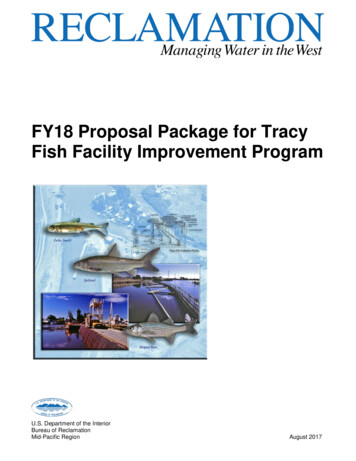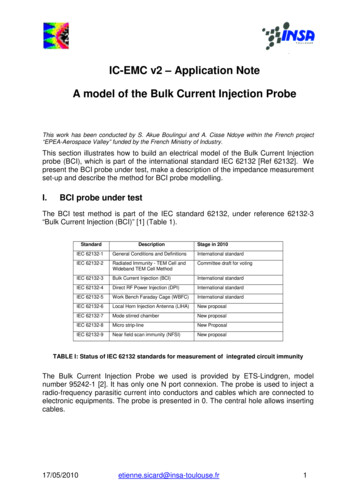
Transcription
FY18 Proposal Package for TracyFish Facility Improvement ProgramU.S. Department of the InteriorBureau of ReclamationMid-Pacific RegionAugust 2017
Mission StatementsThe mission of the Department of the Interior is to protect and provide access to our Nation’s naturaland cultural heritage and honor our trust responsibilities to Indian Tribes and our commitments to islandcommunities.The mission of the Bureau of Reclamation is to manage, develop, and protect water and relatedresources in an environmentally and economically sound manner in the interest of the American public.Tracy Fish Facility Improvement ProgramJ. Carl Dealy, Program ManagerBureau of Reclamation – South-Central California Area OfficeTracy Office16650 Kelso RoadByron, CA 94514Tracy Series EditorsZachary A. SutphinBureau of Reclamation – Technical Service CenterFisheries and Wildlife Resources, 86-68290P.O. Box 25007Denver, CO 80225-0007Connie D. Svoboda, P.E.Bureau of Reclamation – Technical Service CenterHydraulic Investigations and Laboratory Services, 86-68560P.O. Box 25007Denver, CO 80225-0007CoverFish photography by René Reyes, Tracy Fish Collection Facility, Tracy, California.Design by Doug Craft.DisclaimerMention of commercial products does not constitute endorsement.
Table of ContentsPageAssessing the Efficacy of a Modified Fish Salvage Release Scheme to Reduce PredationLoss of Juvenile Salmonids at the Sacramento-San Joaquin River Delta Release Sites .1Whole Facility Efficiency Evaluation for Chinook Salmon at the Tracy Fish CollectionFacility . 14Near-Field Export Effects on Predation, Survival, and Entrainment on Juvenile Salmonids . 23Evaluation of Hydrolox Traveling Screen at the Secondary Channel using Larval andJuvenile Delta Smelt . 34Determining Optimal Carbon Dioxide Concentration for Implementation of CarbonDioxide Predator Removals in the Bypass Pipes and Secondary Channel at the TracyFish Collection Facility . 39Estimation of Biomass Capacity of the Tracy Fish Collection Facility Fish-Haul TrucksBased on Oxygen and Aeration System Capabilities and Published Oxygen Consumption,Ammonia Production, and Carbon Dioxide Production Rates . 44Feasibility of Using Carbon Dioxide to Remove Piscivorous Fish from the Tracy FishCollection Facility Primary Channel . 48Tracy Fish Facility StudiesPage iii
Assessing the Efficacy of a Modified Fish Salvage ReleaseScheme to Reduce Predation Loss of Juvenile Salmonids at theSacramento-San Joaquin River Delta Release SitesInvestigatorsClarence FullardFisheries BiologistFisheries and Wildlife Resources GroupBureau of Reclamation, Technical Service CenterDenver, CO. 80225cfullard@usbr.govZachary A. SutphinFisheries BiologistFisheries and Wildlife Resources GroupBureau of Reclamation, Technical Service CenterDenver, CO. 80225zsutphin@usbr.govBrandon WuFish BiologistTracy Fish Collection FacilityBureau of ReclamationByron, CA. 94514bwu@usbr.govJavier MirandaSenior Environmental ScientistCalifornia Department of Water ResourcesSacramento, CA. 95814Javier.Miranda@water.ca.govSummaryMany resident and transient species of fish to California’s Sacramento-San Joaquin River Delta(Delta) have declined markedly from drought, habitat modification, water diversions, and otherimpacts (Bennett and Moyle 1996, Brown et al. 1996, Moyle 2002). The United States Bureau ofReclamation (Reclamation) Tracy Fish Collection Facility (TFCF) was built in the 1950s todivert and salvage juvenile Chinook salmon (Oncorhynchus tshawytscha) and striped bass(Morone saxatilis) in the Sacramento-San Joaquin River system from entrainment in the DeltaMendota Canal via the Jones Pumping Plant (JPP; Bates et al. 1960), which provides freshwaterdeliveries for the Central Valley Project. The fish salvage process uses a louver-bypass systemwhich intercepts fish from entrainment and pump- induced mortality at the JPP. Though thefacility was designed to salvage juvenile Chinook salmon and striped bass, all fishes— includingnon-native species—are captured and transported to downstream release sites in the Delta.Tracy Fish Facility StudiesPage 1
From 2000 to 2003, TFCF operations resulted in the salvage of roughly seven million fish peryear (Reclamation 2009), including an annual average of 31,900 federally protected Chinooksalmon (winter and spring runs; Federal Register 70(123):37160-37204, June 28, 2005). Sincethat time, annual salvage of Chinook salmon of all runs has declined to relatively low levels(Figure 1 and Table 1). The National Marine Fisheries Service’s (NMFS) 2009 BiologicalOpinion determined that the long-term operations of the JPP adversely affects endangeredwinter-run and threatened Central Valley spring-run Chinook salmon, and directed Reclamationto take actions at the TFCF to increase Chinook salmon salvage efficiency and end-of-pipesurvival (i.e., release site predation; NMFS 2009). Though release site predation has been aconcern for decades, common methods such as netting, mark and recapture, stomach analysis,other common fisheries science methods are not easily applicable to end-of-pipe and large opensystems such as the Delta. Therefore, losses due to predation at release sites has not been wellquantified.Figure 1. Annual salvage of Chinook salmon (all runs and origins combined) at the Tracy Fish Collection Facilityduring water years 1981-2014.Table 1. Annual salvage of Chinook salmon (all runs and origins combined) at the Tracy Fish Collection Facilityduring water years 2013-2017. 2017 data is current as of 5/14/2017.Year20132014201520162017 to datePage 2Salvage of ChinookSalmon3,7141,2641061,38312,908Tracy Fish Facility Studies
Problem StatementSurvival of salvaged fish at Delta release sites is likely dependent on water temperature, seasonalpredator and prey assemblage variability, diurnal behavioral changes, frequency of site-specificreleases (e.g., number of releases per day), tides, river discharge, and total abundance of fish ineach release. Miranda et al. (2010) conducted a release site predation study from 2007 – 2008,which concluded predation of salvaged fish does occur at California Department of WaterResources (DWR) and other fish salvage release sites, and that predatory fishes tend to remainnear the release sites when the number of fish being released is consistently high. Salvaged fishwere also vulnerable to bird predation when released during the daylight hours. The studydetermined that predation at release could have a substantial effect on salvaged fish survival.However, the study did not attempt to estimate a precise rate of predation mortality, which is ametric that is highly sought after by regulatory agencies as well as operating agencies(Reclamation and DWR).Quantifying release site predation is a driving research question for both TFCF and DWRoperations. Because of the nature of release pipe structures (dark, inaccessible) and locations(e.g., deep-water, high-flow, turbid environments), traditional fisheries research techniques areill-equipped to provide accurate assessments of salvaged fish predation rates at each release pipe.Concurrently, there have been few attempts to accurately define or describe the size of thepredation area outside of release pipes, and those that have defined the area of study have doneso based on sampling gear (Miranda et al. 2010, Tucker et al. 1998).Project HistoryFrom September 2016 to May 2017, we established an interagency review team consisting offisheries biologists from Reclamation, DWR, California Department of Fish and Wildlife(CDFW), NMFS, and United States Fish and Wildlife Service. We also consulted formally andinformally with the United States Geological Survey (USGS) and consulting companies ESABiological Resources and Cramer Fish Sciences. The goal of the team was to thoroughlyexamine the problem of release site predation, identify past and current research that can informfuture release sites studies, examine and discuss emerging fisheries research tools which can beused for release site studies, establish and vet a research ideology, and coordinate release siteresearch with other Delta studies being conducted now and into the future. We also consultedwith NMFS regarding the current Central Valley Project Biological Opinion (NMFS 2009) toensure any research direction we take to lessen the extent of release site predation will be in linewith Reasonable and Prudent Alternatives laid out in the document.Our team identified a range of variables that, based on best professional judgement and otherpublished and grey literature, are likely to affect salvaged salmonid survival post-release at theDelta release sites. They include, but are not limited, to the following: Time of day of fish releases Ambient light Water temperature Tidal conditions Abundance of released fish in haul truckTracy Fish Facility StudiesPage 3
Time since last release (frequency of releases) Predator abundance Salmon sizeOur team also identified multiple avenues of research which could answer our most pertinentresearch questions:1) How can we spatially and temporally define release site predation?2) What is the current level of release site predation?3) Can release site predation be reduced past any natural or background levels, if noelevated predation rate is discovered at end-of-pipe areas?4) If predation can be reduced, what is the most cost-effective and easy to implementmethod for reducing release site predation by 50 percent?In addition to scoping out broad scale questions regarding release site predation, our teamidentified a number of different methodologies which can provide answers to these questions.Reclamation and DWR staff lab and field tested some of these methodologies, including:Assessing predation loss via predation detection tagsMuch interest was focused on the use of emerging predation-detection acoustic transmitters(tags) as a tool to easily detect predation events. Many vendors are developing methods to detectpredation events using sensors and triggers integrated within acoustic tags. Two maindevelopmental avenues include dissolvable biopolymers and accelerometers, though others areinvestigating methods to use predator filter algorithms to identify behavioral differences betweenpredators and prey using multi-dimensional fish tracks.Reclamation’s Technical Service Center, with assistance from DWR and ESA BiologicalResources, lab tested VEMCO V5-D predation detection acoustic tags (biopolymer based) toassess the time from tagged prey consumption to predation detection signal activation. Theresults indicate there is high variance in the trigger “lag”, which is too long ( 5-30 hours; Figure2) to accurately attribute a predation event to a predator aggregation at release sites. Pendingresults from a field test of these tags, it is unlikely that these tags can improve our understandingand/or definition of release site predation.Page 4Tracy Fish Facility Studies
Figure 2. Lag time (hours) of V5-D (VEMCO Predator Tag) following consumption of tagged juvenile rainbow trout byadult striped bass (695-788 mm total length) at 14 or 21C. Low gut fullness (low) was defined as one rainbow troutprey item, and high gut fullness (high) was defined as 3-4 rainbow trout prey items. Four replicates were completedfor all treatment conditions, except at 21C High (n 3).Assessing predation using trammel netsDeployment of trammel nets at the release sites was proposed in the initial pilot year to examinepredator diets and look for signs of predation on photonically marked Chinook salmon, whichwere to be added to regular fish releases. Predator total abundance was to be assessed usingDIDSON camera technology, and species-specific abundances were to be estimated by assigningpercent abundance of each species caught in the trammel nets to the total abundance fromDIDSON data. Technical problems with the DWR pumping plant caused a lapse in salvaged fishreleases and created logistical problems for assessing predation at the Horseshoe Bend releasesite, and we did not field test this method. However, after site visits and other testing wedetermined that trammel netting at the release sites would be too difficult to undertake in a largescale study, as currents can be strong, debris loads can be seasonally high, and marine mammalsare occasionally present. DIDSON footage was collected during pilot phase work in spring 2017and will be examined in late 2017 to look for patterns in predator aggregations during releases.Assessing predator movements at the Curtis Landing release siteIn lieu of trammel netting, we opted to evaluate predator movement at the Curtis Landing releasesite. We utilized existing acoustic tags and acoustic receivers available from DWR otherresearchers in the region. Our group externally tagged striped bass caught via hook-and-line atthe Curtis Landing Release Site with VEMCO V5 acoustic transmitters in April (n 11) andMay (n 8) 2017 (May data has yet to be downloaded from hydrophones or analyzed). Wefound that a large portion of tagged striped bass captured within close proximity to the releasesite made rapid downstream and upstream movements ( 1 km in less than one day). This isTracy Fish Facility StudiesPage 5
problematic for any study assessing predation with a near-field ( 2 km upstream ordownstream) acoustic arrays, as many acoustically tagged salmon could end up in predatorstomachs and could be detected leaving and reentering the study area repeatedly, obscuring ourinterpretation of survival and predation in the near-field area using either traditional acoustic tagsor predation-detection acoustic tags with long trigger times. The aforementioned results suggestthat if acoustically-tagged Chinook salmon were released from the pipes, receiver placementwould need to be far ( 2 km based on pilot testing and professional judgement) downstream toavoid ambiguity in data interpretation from acoustic tags (implanted in Chinook salmon) whichare present in predator stomachs.Assessing predation using tethered feeding experimentsTo assess the effects of near-field predation from predators, we will soon (May 2017) explore theutility of Predation Event Recorders (PERs; Figure 3; Demetras et al. 2016) as a tool to quantifyrelease site predation. Each PER can be tethered to a salmon and fished to capture predator ID(via camera), GPS location and time stamp of predation event, temperature and light level at timeof predation, and a visual signal (strobe light) that a predation event had occurred. These may notbe suitable for large scale release site studies, as the tether at the bottom of the unit (see Figure 3)is depth limited, and may not be indicative of the predation rates happening at near-bottomdepths. However, other tethering setups can provide insight into predation at various waterdepths.Figure 3. Schematic of a Predation Event Recorder (PER) with a baited tether. Developed by the National MarineFisheries Service, as described in Demetras et al. 2016. Figure from Demetras et al. 2016.Page 6Tracy Fish Facility Studies
Assessing feasibility of paired releases of Juvenile Salmon Acoustic Telemetry SystemtransmittersPaired releases of acoustically tagged fish using Juvenile Salmon Acoustic Telemetry System(JSATS) acoustic transmitter tags (tags) might provide for an assessment of treatment effects atrelease sites by comparing current release schemes to modified schemes (e.g., rotationalschedules, night/day releases, etc.). JSATS tags are small (217 mg in air, 15 mm x 3.38 mm)injectable acoustic transmitters which can be implanted into salmon at roughly 80 mm forklength. They can be used with salmon representative of sizes salvaged in late winter and earlyspring.Other brands of acoustic transmitters are not available in sizes as small as JSATS tags, andpublished tag-body burden limitations would need to be assessed carefully if larger tags are used.In addition, the majority of acoustic studies being conducted in the Delta now and into the futurewill use JSATS technology. National Marine Fisheries Service Southwest Fisheries ScienceCenter installed a JSATS receiver gate spanning the Delta at Chipps Island in 2017, and plan todo so again in 2018 and beyond. This is an ideal location to measure survival from the releasesites, as it is the next downstream “pinch point.” Closer locations were considered for acousticarrays to improve precision to detect release site mortality, however our pilot data suggests thatpredators move rapidly through our study area and could overwhelm our analysis andinterpretation of acoustic data if they consume experimental fish.A key challenge to the use of acoustic tags to assess the impact of release site predation mortalityis that acoustic tags can only estimate survival from release location to Chipps Island (S) andcannot distinguish between predation mortality near the release site (Mp) and other sources ofmortality (Mr).S 1 – (Mp Mr)Qualitative interpretation suggests the following:1) The greatest probability of detecting a change in S will occur when Mp is relatively large( 0.1) and strongly affected by the treatment;2) When values of Mp and/or S are low, a change in S will be difficult to detect regardlessof how strongly the treatment influences Mp; and3) Large values of Mr or variability in Mr will generally obscure detection of changes in Srelated to Mp.Simulations can provide a way to understand the probability and impacts of treatment effectsprior to performing field experimentation. We consulted with Cramer Fish Sciences quantitativebiologists to run simulations to estimate release sizes needed to detect a treatment effect atChipps Island. Results indicated that there is a large amount of uncertainty in estimatesassociated with a single release of a small number of fish (n 20). This uncertainty is highenough that detecting treatment effects from single releases is unlikely.We decided against pursuing any JSATS or other mass-releases of acoustically tagged salmon in2018. Estimates of survival through the vicinity of our study site (Sherman Island to ChippsIsland) are available from published and unpublished data (Perry et al. 2010; Cramer FishTracy Fish Facility StudiesPage 7
Sciences, personal communication) and can provide one variable for simulation of release sizesneeded to detect a treatment effect. Initial simulations indicate that we may need at least 80-120tags per replicate release, and possibly more if release site mortality is low, or the treatmenteffect is small. Our inability to know ahead of time the number of tags needed per release makesus weary of using a mass release approach, because our ability to measure a treatment effect mayrequire hundreds of tags (costing upwards of 300,000 or more), and we won’t be confident thatsuch an investment will provide statistically defensible results. Further modeling work isrequired to assess adequate tag release sizes, and be assured that tag releases would be able toprovide meaningful data.GoalsBased on our interagency working group’s collective experience, best available scientific data,and results of our 2017 field research, we are proposing to conduct a feasibility and initial year ofstudy of 1) the use of tethered predation experiments to assess release site and non-release site(i.e., baseline) predation rates, 2) externally mounted VEMCO predation detection acoustic tagtechnology, and 3) the use of injectable JSATS acoustic tags to track salvaged fish to adownstream hydrophone array to measure survival. Using multiple lines of evidence, we thinkthat these various technologies may be able to provide us accurate estimates of release sitepredation, though each technique needs to be tested before large scale studies are pursued. The2018 feasibility study will provide data to progress towards the development of a statisticallydefensible study design for implementation in 2019.Tethered predation experimentsOur goal under this proposal is to develop and refine a tethering experiment that can beconducted within high-velocity environments at state and federal release sites. An extensiveliterature search will provide insight into past studies of riverine tethering studies. Refinement offield techniques will provide information on tether length, number of tethered prey, tethered preyloss (via lab experimentation), and number of tethering units to be used at each release site. Afterrefinement, our goal is to conduct tethering experiments in 2018 to examine release site and nonrelease site predation rates of tethered fish, which we assume to be indicative of live fishpredation rates. This will be conducted at the proof-of-concept level, and hope to 1) see if this isa suitable technique for current and future studies, and 2) collect enough data at this feasibilitystage to determine the number of replicates and fish per location we need for statisticallydefensible results.VEMCO predation detection tagsOur goal for further testing of VEMCO V5D predation detection acoustic tags is to determinewhether external tagging will provide for more accurate and timely signal change times (i.e., lagtime) than traditional surgical implantation. Current signal change times with VEMCO V5-Dtags have been deemed by the project team too long to provide utility for release siteexperiments. However, we hypothesize that an externally attached transmitter will reduce triggertime and variability of trigger times post consumption, which may ultimately permit the use ofthis technology as an appropriate tool for detecting near field predation at the release pipes.External tag attachment is likely to affect swimming performance and behavior of juvenilesalmon, and we plan to assess such effects in a laboratory setting.Page 8Tracy Fish Facility Studies
JSATS downstream releasesThe concept of mass releases of acoustically tagged fish is proven and accepted, however theuncertainty of release site predation loss confounds our ability to determine the number of tagsneeded for each release. Our goal under this proposal is to work with quantitative fisheriesbiologists at Cramer Fish Sciences to run simulations of releases and determine the number oftags we may need to release per replicate in order to detect a treatment effect. This can inform alarger scale 2019 acoustic tag release project, which could take advantage of the future DWRrelease sites which are in close proximity to one another and would make for a good pairedrelease study design. The tethering experiments proposed here will provide release site predationdata that, to date, is unknown and will be necessary to build these simulations to get the mostaccurate estimates of sample size requirements.Materials and MethodsTethered predation experimentsMay, June) at two of the four release sites. We will coordinate with state and federal operators toimplement a rotational release schedule, which in theory can reduce any learned behaviorexhibited by Delta predators. This proposal will assess the feasibility of this technique, and mayprovide accurate estimates of spatial and temporal differences in release site predation. Theseestimates will feed simulation models to estimate number of JSATS tags required per release andallow a power analysis to estimate the number of required replicates for future studies.Though PERs are a preferred predation study tool by NMFS, and they were assessed in 2017with training provided by NMFS, the depth, turbidity, and velocity at which they can be fished islimited. We propose to use a non-PERs tethering design. Our tethers will be custom built, butwill resemble commercially available trotlines. They will be hook-less and will contain from topto bottom: Float Main line Lightweight (2lb) monofilament individual tether loops spaced every 12” and connectedto the mainline via swivels (fishing at various depths) Lightweight anchor (5lb)Live fall run Chinook salmon or rainbow trout (pending approval from DFW) will be used astethered prey. Tether loops will go through gill cover and out the mouth, and then around thebody of the fish. When predation events occur, the thin monofilament line will cut through andrelease the fish from the tethering unit (this is a similar technique that has been tested and usedby NMFS). Four to eight tethering units will be fished at each of the four release sites, as well astwo randomly selected non-release pipe sites. If a tether unit is set with 10 fish, soaked for 30minutes, and contains only 2 fish at the end of the soak, then the predation rate will be assumedto be 80%. We will spend a short period of time prior to the start of the experiment refining ourtechnique, appropriate number of tethered prey fish, soak time, and project logistics, since suchtethering experiments are a novel, but simple approach to release site studies in the Delta.Tethering fish compromises their ability to swim naturally and evade predators, but still allows acomparison of predation loss between sites.Tracy Fish Facility StudiesPage 9
Lab studies at the TSC fisheries research center in Denver, Colorado will be conducted to assesstethered fish loss from current. We will test effects of various velocities in a test flume to providean average rate of tethered fish loss (non-predation loss), which we will use to correct ourestimates of predation loss based on water velocities at the release sites.The rotational release site schedule will provide for “resting” periods for individual release pipeswhile releases are conducted at the other sites. Two release sites will change from the standardrelease schedule (daily releases) to releases only every 5th day (treatment), while one site willremain on the once daily release schedule (control). We will attempt to collect data for tetheredreplicates at the same tidal and diel conditions.Excess fish salvage releases will be conducted at the two new DWR release sites to ensure thecontrol sites don’t experience higher than normal releases. The new DWR release sites will notbe part of any 2018 studies, but will be the focus of future studies. Based on the recentMemorandum of Understanding (MOU) developed between DWR and Tracy Fish CollectionFacility for shared release sites, this rotational release schedule is a feasible future scenario andcan be easily implemented.During the treatment release scheme, we expect to see differences in predation loss of tetheredfish between control and treatment release schedules. If any Delta-wide differences in predationrelated to temperature, predator abundance, predator activity, or other seasonal changes occur,our control site will measure those changes and it will not be falsely attributed to the treatment.By reducing the frequency of releases, we believe that predator aggregations will decrease as aresult of fewer stimuli (e.g., water pumps, truck noise, gates opening/closing) and payouts (i.e.,higher variability in release times creating long waits between feeding frenzies).We also propose to conduct a natural, or baseline predation measurement by performing tetheredexperiments away from the assumed predator aggregations (Miranda et al. 2010, Kano 1987) atnearby locations with similar offshore distance and water depths (e.g., 15 m offshore and 25 mdeep) as state and federal release sites. We will randomly select natural predation assessmentsites by randomly choosing shoreline segments 25 m in length from 2 km upstream of the mostupstream release site to 2 km downstream (exact distances will be assessed before the start ofthis project) of the most downstream release site. This will indicate whether there is a differencein predation between release sites and unaffected sites in the Delta.Diel period may also have an influence on release site predation, so this study will also examinethe effects of day vs night predation by performing exploratory night vs day tethered experimentsto examine differences in predation rates. We will conduct these night experiments at the naturalpredation assessment sites during similar tidal conditions. This will help us quantify differencesin predation as a function of diel periodicity.Predator assemblage assessmentsAt the end of each tethering month, we will spend one day performing a shoreline electrofishingsurvey and a second day performing a hook and line angling survey (two days per month for fourmonths). Based on successful hook and line angling results in 2017, we believe that thismethodology can accurately provide catch-per-unit-effort data for release site predators locatedat a variety of depths. Hook and line surveys may use either rod and reel or trotlines (hooked).Page 10Tracy Fish Facility Studies
Understanding the specific predator abundance at each site will guide our release site predationreduction efforts, as we can formulate release site strategies that take advantage of specificpredator feeding behaviors (e.g., releases at night could be an obvious tactic if the majority ofpredators are daytime sight-feeders).VEMCO predation detection tagsDiscussions with a VEMCO staff biologist led to the idea of externally tagging juvenile Chinooksalmon with their V5-D predation detection tag. External, versus internal, tagging may providefor significantly shortened trigger times, which may enable us to use them for release sitepredation studies. We propose to run a follow up lab study to the one conducted in 2017, but thistime we will use smolts with pairs of tags, one surgically implanted and other externally attachedwith sutures. We will compare trigger times between the two tags and assess whether the reducedtrigger time can provide a sufficient level of efficacy for field trials.JSATS downstream releasesAfter initial sample size modeling in 2017, we propose to consult with fish biologists withexpertise in survival modelling to accurately assess t
Oct 05, 2017 · P.O. Box 25007 . Denver, CO 80225-0007 . Cover . Fish photography by René Reyes, Tracy Fish Collection Facility, Tracy, California. Design by Doug Craft. Disclaimer . Mention of commercial products does not constitute endorsement.










